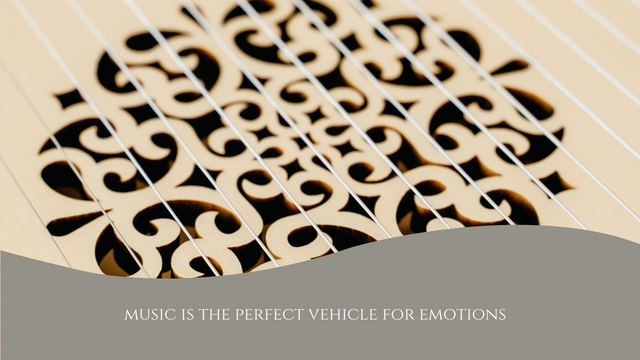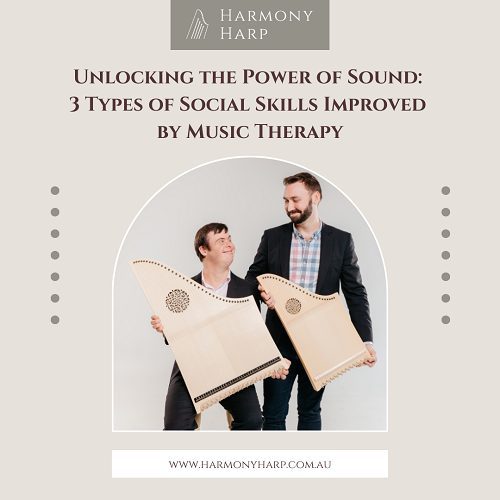Unlocking the Power of Sound: 3 Types of Social Skills Improved by Music Therapy
From the time we’re in our mothers’ wombs, sound plays a crucial role in preparing us to be part of the world. The voices and music we hear in utero shape our early preferences.
Consequently, music is a powerful tool for developing and improving social skills, especially for individuals with special needs who may otherwise struggle to acquire these skills.
How, you may ask?
People with special needs often experience deficits in communication and socialisation. Music therapy bridges this gap, providing the necessary social skills to function in society
As a phenomenon that transcends speech, music is the perfect vehicle for emotions and the nonverbal grey area that poses a huge challenge for some individuals with special needs.
For some individuals, it’s possible to rely on the structure and predictability of music to practise fundamental social skills.
We’ll jump straight into three social skills that music therapy improves. We’ll also look at:
How music therapy corrects language deficits common in people with special needs
Which interventions music therapists use to foster the learning of key social skills
Why choosing an elementary instrument for people with disabilities is important
1 - Music Universally Enhances Communication Skills
Difficulties in speech, language, social skills and social behaviour can lock people with special needs out of education, employment and community participation. Thankfully, music therapy can help to improve their communication skills.
As many as 28–49% of individuals with special needs have impaired communication skills because they struggle to vocalise, understand or offer others nonverbal cues, and they often miss nuances in meaning.
Considering that communication is 55% non-verbal, neurodivergent people, such as those with autism spectrum disorder (ASD), are at a severe disadvantage in any social setting.
This is where music therapy comes in. The universal language of sound may help to improve:
Poor nonverbal conversation skills: Inability to use gestures, touch, eye contact or facial expressions to communicate
Echolalia: Repetitive language with no meaning or no connection to the current conversation. For example, repeating a question as asked and being unable to construct an answer
Uneven language development: Mastery of strong vocabulary related only to their area of interest
Deficiencies in language comprehension: Deficits in executive function, decoding, working memory and sensory processing may contribute to this
Music therapists use a variety of interventions tailored to their client’s needs and goals towards improving their communication skills.
Lyric Analysis
Through the guidance of a therapist, listening to music and analysing the lyrics of a song can improve comprehension skills. This activity also helps one develop a broader vocabulary, thus deepening their understanding of language.
Guided Singing
With this technique, the therapist uses familiar or original songs to help their client practice sounds and learn the appropriate use of words and phrases. Singing words and phrases can improve overall communication skills by enhancing speech production, intelligibility, fluency and breath control.
Rhythmic Speech Therapy
The rhythm and beat of drums and other percussion instruments are useful in improving abnormal speech patterns. These include excessive repetition and over-coarticulation, or atypical disfluency.
Improvisational Music Making
The spontaneity and responsive nature of musical improvisation can lead one to develop skills like active listening—listening and giving appropriate feedback. The back and forth of creating music through improvisation also hones one’s understanding of nonverbal communication and the ability to present or question new ideas.
Expert Tip: Individuals with special needs may struggle to develop the fine motor and music reading skills necessary to play instruments to their satisfaction. In such cases, percussion instruments has often been a great place to start. Now, the Veeh Harp has burst onto the music therapy scene offering an extremely accessible stringed instrument option that uses an elementary notation system, making it easy-to-use for people of all ability levels.
2 - Music Therapy Unlocks Emotional Regulation Pathways
Have you ever wondered why listening to a sad song can sometimes ease feelings of sadness? Music activates the brain’s emotional and behavioural response centres. That’s why music can be a keystone in emotional regulation, especially for people with disabilities.
Mood and emotional regulation can be a challenge for people with intellectual disabilities, ASD or developmental conditions, such as attention-deficit/hyperactivity disorder (ADHD).
Since their brains process information atypically, they often struggle to:
Interpret social cues in body language, tone of voice, facial and eye expressions
Respond appropriately in social situations
Cope with daily life challenges, such as maintaining personal hygiene, chores, unexpected changes in routine, or even multitasking
Adapt to changing situations and switch their mode of thinking (cognitive inflexibility)
Communicate effectively, using both verbal and nonverbal skills, to make themselves understood
Regulate their sensitivity to sensory stimulation such as unusual sounds, smells or textures
When combined, these difficulties can escalate a mild emotional response into an outburst of irritability, aggression or anxiety.
For instance, a minor change in routine meals or object placement can sometimes make someone with special needs inconsolable.
Music therapy helps such individuals decipher what they’re feeling and why. Equally important, it gives them the language to communicate these emotions to others.
What do these musical interventions look like in practice?
Music-Assisted Relaxation
Learning to cope and walk oneself back from the precipice of an emotional meltdown is a crucial social skill.
During music-assisted relaxation, smooth, simple, slow music that’s pleasant to the listener marks various relaxation cues.
For instance, there are distinct sounds for inhaling and exhaling to guide deep breathing; a downward or upward progression of chords imitates the movement of the breath. These same sounds can later be used to help trigger relaxation in the face of stress triggers.
Emotional Exploration Through Music
Despite their intensity, emotions and their root cause can be difficult to decipher.
Emotional exploration with the guidance of a music therapist involves listening to music and identifying the primary emotion in it.
As the participant discusses the emotions they sense in the music, they’re invited to connect to their own emotions and process them.
Songwriting with Guided Imagery
Particularly great for children and nonverbal individuals, songwriting using images makes communicating emotions easier.
People with ASD and other developmental disorders often respond better to visual cues rather than verbal ones. Words tend to be a confounding, unwieldy tool for them.
Using images, songwriting takes the form of a story that culminates in a resolution. The activity equips the client with tools to express and explore their emotions.
3 - Music Helps to Navigate Social Interaction and Collaboration
Music is inherently social, communicative, and directed towards others. In the same way that a familiar song can break the ice between strangers, music therapy is an excellent initial point of contact for people with special needs to develop social skills.
So far, we’ve discussed the challenges that people with special needs face when it comes to mastering communication skills and emotional regulation.
They crave social connection but lack the social skills to engage with others, and may feel overwhelmed by new people and experiences.
Music therapy provides:
A safe, non judgemental space for the participant to question the application and reasoning behind social skills. For instance, what’s the reasoning behind maintaining eye contact and how long is it appropriate to hold eye contact for?
Structure and predictability through music itself, and the guidance of the therapist, helps them overcome organisational challenges and the anxiety caused by inconsistency, allowing them to thrive
Synchronous movement, cooperation and shared purpose which create a starting point for building social connections
Group environments that include multiple opportunities to learn social skills, including turn taking, empathy, sharing emotions and social reciprocity
Group Singing and Rhythm-Based Activities
We group these two intervention methods together because the idea behind them is for the individuals in therapy to make music together through singing, clapping, tapping or dancing.
As they work in tandem on the same musical creation, they sharpen certain social skills. From collaboration and turn-taking to coordination and timing, they learn how to operate successfully in a social context.
Simple acoustic instruments, such as a keyboard, ukulele or Veeh Harp, work well for group sessions, preserving the authenticity and closeness of the performers.
Music-Based Social Skills Training and Group Therapy
Social skills training offers young people with ASD and other disabilities safe and structured opportunities to practise social skills with each other or their peers.
Group therapy focuses on processing emotions and difficult life experiences for better mental health and wellness.
When these two activities are music-based, individuals with special needs can access another level of openness. It’s easier to understand and communicate emotions through music than it is to do so with speech - they develop social skills like cooperation and empathy.
Unlock the Power of Sound With Harmony Harp
Music therapy is a powerful tool that can help people with special needs access and develop key social skills. As they move through their therapy interventions, they develop their skills in communication, emotional regulation and social interaction.
Each of these skills will also boost their self-esteem because they now have the tools to be a part of the world rather than apart from it.
To recap, we’ve summarised the benefits music therapy can have on social development in the table below.
| Music Therapy Intervention | Social Skills Developed |
|
Group singing Improvisational music making |
|
| Rhythm-based group activities |
|
|
Music-based social skills training Music-based group therapy |
|
| Songwriting |
|
| Music-assisted relaxation |
|
Music therapy aligns with our mission at Harmony Harp - to bring the connection of music and the legacy of the Veeh Harp to everyone, regardless of background, age or ability.
To learn more about the Veeh Harp, designed and constructed with love, drop us a line.





